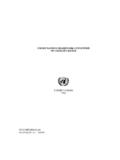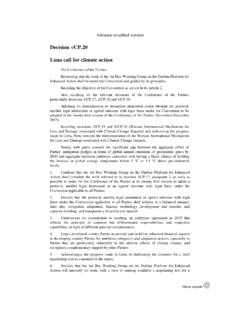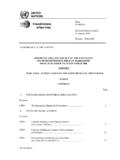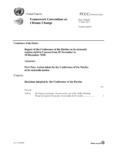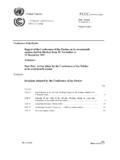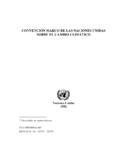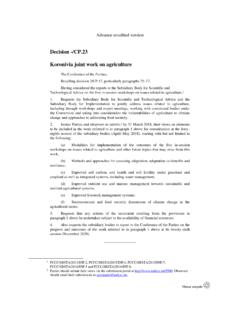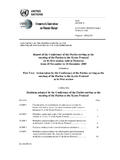Transcription of United Nations Framework Convention on Climate Change
1 United Nations Framework Convention on Climate Change Fact sheet: Climate Change science - the status of Climate Change science today February 2011 page 1 of 7 The World Meteorological Organisation (WMO) describes the build-up of greenhouse gases in the atmosphere during the 20th century as resulting from the growing use of energy and expansion of the global economy. According to the WMO, the build-up of greenhouse gases in the atmosphere alters the radiative balance of the atmosphere. The net effect is to warm the Earth's surface and the lower atmosphere because greenhouse gases absorb some of the Earth s outgoing heat radiation and reradiate it back towards the surface. The most recent comprehensive assessment of the science was undertaken in 2007 by the Intergovernmental Panel on Climate Change (IPCC) on the causes, impacts and possible response strategies to Climate Change . The conclusions are supported by a wide range of the world s leading scientific institutions including the US s National Oceanic and Atmospheric Administration (NOAA).
2 During 2010, there has been widespread debate about Climate science particularly as a result of errors which emerged in the last (2007 AR4) IPCC report. None of the errors alter the fundamental conclusions of the IPCC s AR4, namely that Climate Change is the result of human activity, that the phenomenon will have devastating effects if left unchecked and that cost of action on Climate Change are significantly lower than the costs of inaction. Following a review by the InterAcademy Council (IAC), the IPCC has announced that it will strengthen a number of its processes and procedures. The IPCC Fifth Assessment Report (AR5) will be published between 2013 and 2014. During 2010, several regions of the world experienced what the WMO terms severe weather related events . These included flash floods and widespread flooding in large parts of Asia and parts of Central Europe. Other regions were also affected: by heatwave and drought in the Russian Federation, by mudslides in China and severe droughts in sub-Saharan Africa.
3 The WMO stated that while a longer time range is required to establish whether an individual event is attributable to Climate Change , the sequence of current events matches IPCC projections of more frequent and more intense extreme weather events due to global warming. The IPCC Fourth Assessment Report The IPCC Fourth Assessment Report Climate Change 2007 comprises contributions from the three working groups on 1) the physical science, 2) Climate Change impacts, adaptation and vulnerability and 3) mitigation of Climate Change , and the Synthesis Report. Definitions of Climate Change Climate Change in IPCC usage refers to a Change in the state of the Climate that can be identified ( using statistical tests) by changes in the mean and/or the variability of its properties, and that persists for an extended period, typically decades or longer. It refers to any Change in Climate over time, whether due to natural variability or as a result of human activity. United Nations Framework Convention on Climate Change February 2011 2 This usage differs from that in the United Nations Framework Convention on Climate Change ( unfccc ), where Climate Change refers to a Change of Climate that is attributed directly or indirectly to human activity that alters the composition of the global atmosphere and that is in addition to natural Climate variability observed over comparable time periods.
4 Working Group I: The physical science Warming of the Climate system is unequivocal and can now be firmly attributed to human activity. Numerous long-term changes in Climate have been observed at continental, regional and ocean basin scales, including changes in arctic temperatures and ice, widespread changes in precipitation amounts, ocean salinity, wind patterns and aspects of extreme weather including droughts, heavy precipitation, heat waves and the intensity of tropical cyclones. The 100-year linear warming trend (1906-2005) was C, with most of the warming occurring in the past 50 years. The warming for the next 20 years is projected to be about C per decade. Continued greenhouse gas emissions at or above current rates would cause further warming and induce many changes in the global Climate system during the 21st century that would very likely be larger than those observed during the 20th century. Projections of future changes in Climate indicate for example the following: o Increasing atmospheric carbon dioxide concentrations lead to increasing acidification of the oceans; o Snow cover projected to contract, widespread increases in thaw depth over most permafrost regions; o Sea ice projected to shrink in both Arctic and Antarctic, and arctic late-summer sea ice may disappear almost entirely by the latter part of the 21st century; o Hot extremes, heat waves and heavy precipitation events very likely to continue to become more frequent; o Changes in precipitation patterns, with increase being very likely in high latitudes, while decreases are likely in most subtropical land regions; o Anthropogenic warming and sea level rise would continue for centuries due to the time scales associated with Climate processes and feedbacks, even if greenhouse gas concentrations were to be stabilized.
5 Working Group II: Climate Change impacts, adaptation and vulnerability Observed impacts Many natural systems, on all continents and most oceans, are being affected by regional Climate changes, particularly temperature increases. Observed impacts include: United Nations Framework Convention on Climate Change February 2011 3 Changes in snow, ice and frozen ground (including permafrost); Effects on hydrological systems; Changes on terrestrial biological systems; Trend towards earlier greening of vegetation and longer thermal growing season; Changes in marine and freshwater biological systems associated with rising water temperatures, as well as related changes in ice cover, salinity, oxygen levels and circulation; Ocean acidification with an average decrease in pH of units. The associated effects on the marine biosphere were not documented at the time of the assessment. Projected future impacts As regards the projected impacts, more specific information is now available on the nature of these impacts, across a wide range of systems and sectors.
6 Examples of projected impacts include: Fresh water resources and their management Runoff and water availability are projected to increase at high latitudes and in some wet tropics, and decrease over much of the mid-latitudes and dry tropics, some of which are presently water-stressed areas; Drought-affected areas will probably increase, and extreme precipitation events, which are likely to increase in frequency and intensity, will augment flood risk; Hundreds of millions of people are projected to be exposed to increased water stress. Ecosystems The following ecosystems are identified to be most vulnerable, and are virtually certain to experience the most severe ecological impacts, including species extinctions and major biome changes: ! On continents: tundra, boreal forest, mountain and Mediterranean-type ecosystems; ! Along coasts: mangroves and salt marshes, due to multiple stresses; ! In oceans: coral reefs and the sea-ice biomes. The progressive acidification of the oceans is expected to have negative impacts on marine shell-forming organisms such as corals and their dependent species; An intensification and expansion of wildfires is likely globally, as temperatures increase and dry spells become more frequent and more persistent; Over the course of this century, net carbon uptake by terrestrial ecosystems is likely to peak before mid-century and then weaken or even reverse, thus amplifying Climate Change .
7 Food, fibre and forest products United Nations Framework Convention on Climate Change February 2011 4 Moderate warming benefits cereal crops and pasture yields in mid- to high-latitude regions, but even slight warming decreases yields in seasonally dry and tropical regions. Further warming has increasingly negative impacts in all regions; Increases in the frequency of droughts and floods are projected to affect local crop production negatively, especially in subsistence sectors at low latitudes; Regional changes in the distribution and production of particular fish species are expected due to continued warming, with adverse effects projected for aquaculture and fisheries. Coastal areas and low-lying areas Coasts are very likely to be exposed to increasing risks, including coastal erosion, due to Climate Change and sea-level rise. The effect will be exacerbated by increasing human-induced pressures on coastal areas; In addition to sea level rise, low-lying coastal systems are likely to be affected due to increased risk from extreme weather events; Many millions more people are projected to experience severe flooding every year due to sea-level rise by the 2080s.
8 Those densely-populated and low-lying areas where adaptive capacity is relatively low, and which already face other challenges such as tropical storms or local coastal subsidence, are especially at risk. The numbers affected will be largest in the mega-deltas of Asia and Africa, while small islands are especially vulnerable; Ocean acidification is an emerging issue with potential for major impacts in coastal areas, but there is little understanding of the details. It is an urgent topic for further research. Health Projected Climate Change -related exposures are likely to affect the health status of millions of people worldwide, particularly those least able to adapt, such as the poor, the very young and the elderly. Industry, settlement and society Areas most likely to be affected are the poorer, often rapidly expanding communities near rivers and coasts, which use Climate sensitive resources and are prone to extreme weather; Where extreme weather events become more intense and or more frequent, their economic and social costs are predicted to increase.
9 Regions that will be especially affected United Nations Framework Convention on Climate Change February 2011 5 The Arctic, due to impacts of high rates of projected warming on natural systems and human communities; Africa, because of low adaptive capacity and projected Climate Change impacts; Small islands, where there is high exposure of population and infrastructure to projected Climate Change impacts; Asian and African megadeltas, due to large populations and high exposure to sea level rise, storm surges and river flooding. Working Group III: Mitigation of Climate Change GHG emission trends Global greenhouse gas emissions have grown since pre-industrial times, with an increase of 70 percent between 1970 and 2004 (24 percent between 1990 and 2004); With current Climate Change mitigation policies and related sustainable development practices, global GHG emissions will continue to grow over the next few decades. Mitigation in the short and medium term up to 2030 There is a substantial economic potential1 for the mitigation of global greenhouse gas emissions over the coming decades, sufficient to offset the projected growth of global emissions or reduce emissions below current levels.
10 Mitigation in the long term (after 2030) Global emissions must peak and decline thereafter to meet any long-term GHG ` concentration stabilisation level; The lower the stabilisation level, the more quickly this peak and decline must occur; The most stringent scenarios could limit global mean temperature increases to 2 - above pre-industrial level .This would require emissions to peak by 2015 the latest and decline by 50-85 percent compared to year 2000 emissions by 2050; Mitigation efforts over the next two to three decades will determine to a large extent the long-term global mean temperature increase and the corresponding Climate Change impacts that can be avoided. For IPCC data please see Climate Change 2007 - The Synthesis Report 1 According to the IPCC, economic potential is the mitigation potential, which takes into account social costs and benefits and social discount rates, assuming that market efficiency is improved by policies and measures and barriers are removed.

